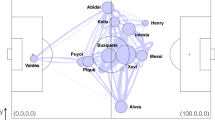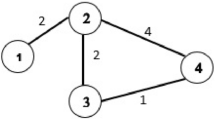Abstract
The popularity of football among fans to analyze the game has been immense with the advent of internet. The concept of making a dream team in football has become a new fashion for the football lovers. The paper focuses in helping achieving this prediction of a football dream team. The aim of this research is to assess the dynamics of a complex topological structure when prompted with random entities whose attributes are known to us. Using graph theory and vectorial distances, the dream team is evaluated on the basis of individual abilities and interplayer synergy. Instead of focusing on discrete events in a match, this framework proposes an idea in which a dream team is quantified on the basis of their positional attributes. Each player is rated in accordance to the position he is playing, which eventually helps in finding the overall team rating. The second part of this research uses graph theory to evaluate structural and topological properties of interpersonal interactions of teammates. Teammates are treated as nodes of a graph, where each edge exemplifies the strength of their interpersonal interaction. The strength of the bond depends on on-field interactions via ball passing, ball receiving and communication which depend on experience of playing together, Nationality and Club. The methodology adopted in this paper can be a formidable basis for similarly situated larger setups involving much larger intricacies. Using this framework, we can see the behavior of a hypothetical topological structure whose node attributes are known to us, thus projecting its performance as a team and individual entities.





Similar content being viewed by others
Availability of data and material
Not applicable.
Code availability
Not applicable.
References
Mackenzie R, Cushion C (2013) Performance analysis in football: a critical review and implications for future research. J Sports Sci 31(6):639–676. https://doi.org/10.1080/02640414.2012.746720
Lago-Ballesteros J, Lago-Peñas C (2010) Performance in team sports: identifying the keys to success in soccer. J Hum Kinet 25:85–91. https://doi.org/10.2478/v10078-010-0035-0
Xiao X, Wu Z-C, Chou K-C (2011) A multi-label classifier for predicting the subcellular localization of gram-negative bacterial proteins with both single and multiple sites. PLoS ONE 6(6):20592. https://doi.org/10.1371/journal.pone.0020592
Taylor JB, Mellalieu SD, James N, Shearer DA (2008) The influence of match location, quality of opposition, and match status on technical performance in professional association football. J Sports Sci 26(9):885–895. https://doi.org/10.1080/02640410701836887
Clemente FM, Martins FML, Couceiro MS, Mendes RS, Figueiredo AJ (2014) A network approach to characterize the teammates’ interactions on football: a single match analysis. Cuadernos de Psicología del Deporte 14(3):3
Rawson ES, Clarkson PM, Tarnopolsky MA (2017) Perspectives on exertional rhabdomyolysis. Sports Med 47(Suppl 1):33–49. https://doi.org/10.1007/s40279-017-0689-z
Glazier PS (2010) Game, set and match? Substantive issues and future directions in performance analysis. Sports Med 40(8):625–634. https://doi.org/10.2165/11534970-000000000-00000
Nobuyoshi H (2006) Modeling tactical changes of formation in association football as a zero-sum game. J Quant Anal Sports 2(2):1–22
Ribeiro J, Silva P, Duarte R, Davids K, Garganta J (2017) Team sports performance analysed through the lens of social network theory: implications for research and practice. Sports Med 47(9):9. https://doi.org/10.1007/s40279-017-0695-1
Silva P, Chung D, Carvalho T, Cardoso T, Davids K, Araújo D, Garganta J (2016) Practice effects on intra-team synergies in football teams. Hum Mov Sci 46:39–51. https://doi.org/10.1016/j.humov.2015.11.017
Clemente FM, Couceiro MS, Martins FML, Mendes RS (2015) Using network metrics in soccer: a macro-analysis. J Hum Kinet 45:123–134. https://doi.org/10.1515/hukin-2015-0013
Korte F, Link D, Groll J, Lames M (2019) Play-by-play network analysis in football. Front Psychol 10:1738. https://doi.org/10.3389/fpsyg.2019.01738
Clemente FM, Couceiro MS, Martins FML, Mendes RS (2014) “Using network metrics to investigate football team players’ connections: a pilot study. Motriz Rev Edcu Fis. 20:262–271. https://doi.org/10.1590/S1980-65742014000300004
Onal H, Inan M, Bozkurt S (2017) A research on mathematical thinking skills: mathematical thinking skills of athletes in individual and team sports. J Educ Train Stud 5(9):133–139
“Relationships between sprinting, agility, and jump ability in female athletes - PubMed.” https://pubmed.ncbi.nlm.nih.gov/17852692/ (accessed Jun. 02, 2022)
Bradley PS et al (2011) The effect of playing formation on high-intensity running and technical profiles in English FA Premier League soccer matches. J Sports Sci 29(8):821–830. https://doi.org/10.1080/02640414.2011.561868
“FIFA 19 player dataset.” https://www.kaggle.com/chaitanyahivlekar/fifa-19-player-dataset (accessed Jun. 02, 2022)
Carling C (2011) Influence of opposition team formation on physical and skill-related performance in a professional soccer team. Eur J Sport Sci 11(3):155–164. https://doi.org/10.1080/17461391.2010.499972
Alonso-Gonzalez A, Alamo-Hernandez P, Peris-Ortiz M (2017) Guardiola, Mourinho and Del Bosque: three different leadership and personal branding styles. In: Proceedings of sports management as an emerging economic activity, vol 1. Springer, Springer, pp 329–244. https://doi.org/10.1007/978-3-319-63907-9_20
Castañer M, Barreira D, Camerino O, Anguera MT, Canton A, Hileno R (2016) “Goal scoring in soccer a polar coordinate analysis of motor skills used by lionel messi. Front Psychol. https://doi.org/10.3389/fpsyg.2016.00806
Ming-jun G, “The Research on Barcelona and Spain Tiki-Taka Football Style,” undefined, 2013, Accessed: Jun. 02, 2022. [Online]. Available: https://www.semanticscholar.org/paper/The-Research-on-Barcelona-and-Spain-Tiki-Taka-Style-Ming-jun/fa9b8722f34c64bb2652f5cc5a46854976604a68
Nesser TW, Huxel KC, Tincher JL, Okada T (2008) The relationship between core stability and performance in division I football players. J Strength Cond Res 22(6):1750–1754. https://doi.org/10.1519/JSC.0b013e3181874564
Taylor R (1990) Interpretation of the correlation coefficient: a basic review. J Diagn Med Sonogr 6(1):35–39. https://doi.org/10.1177/875647939000600106
Warner S, Bowers M, and Dixon M (2012). Team dynamics: a social network perspective. J Sport Manag 26(1):53-66. https://doi.org/10.1123/jsm.26.1.53
Bondy JA and Murty USR. (1976). Graph Theory with Applications. Elsevier, New York
Duarte R, Travassos B, Araújo D, and Richardson M (2013) The influence of manipulating the defensive playing method on collective synchrony of football teams,” In: Performance Analysis of Sport IX, Routledge
Leontijevic B, Jankovic A, Tomić L (2019) “Attacking performance profile of football teams in different national leagues according to Uefa rankings for club competitions. Facta Univ, Ser Phys Educ Sport. https://doi.org/10.22190/FUPES180404062L
Turner BJ, Sayers MGL (2010) The influence of transition speed on event outcomes in a high performance football team. Int J Perform Anal Sport 10(3):207–220. https://doi.org/10.1080/24748668.2010.11868516
Casal CA, Maneiro R, Ardá T, Marí FJ, Losada JL (2022) Possession zone as a performance indicator in football the game of the best teams. Front Psychol. https://doi.org/10.3389/fpsyg.2017.01176
Ruohonen K, Tamminen J, Lee KC, and Piche R (2006), “Graph Theory,” Accessed: Jun. 02, 2022. [Online]. Available: https://researchportal.tuni.fi/en/publications/graph-theory
Gonçalves B, Coutinho D, Santos S, Lago-Penas C, Jiménez S, Sampaio J (2017) Exploring team passing networks and player movement dynamics in youth association football. PLoS ONE 12(1):0171156. https://doi.org/10.1371/journal.pone.0171156
Funding
No financial support.
Author information
Authors and Affiliations
Contributions
All the authors have made substantial contributions to the conception of the work, drafted, revised and approved the version to be published.
Corresponding author
Ethics declarations
Conflict of interest
Not applicable.
Additional information
Publisher's Note
Springer Nature remains neutral with regard to jurisdictional claims in published maps and institutional affiliations.
Rights and permissions
Springer Nature or its licensor (e.g. a society or other partner) holds exclusive rights to this article under a publishing agreement with the author(s) or other rightsholder(s); author self-archiving of the accepted manuscript version of this article is solely governed by the terms of such publishing agreement and applicable law.
About this article
Cite this article
Vyas, A., Parnami, A. & Prusty, M.R. Graph theory-based mathematical modeling and analysis to predict a football dream team. Knowl Inf Syst 65, 1523–1547 (2023). https://doi.org/10.1007/s10115-023-01849-y
Received:
Revised:
Accepted:
Published:
Issue Date:
DOI: https://doi.org/10.1007/s10115-023-01849-y




